Back-end Developer?!
Learn, Code, Ship, Repeat

What do you get when you cross a designer with a database?
I’m an experienced designer and front-end developer, but my work usually stops when the front-end connects to the back-end. I’d tried learning back-end development years ago, but for many reasons (one being my own impatience), it didn’t take.
I would like to take credit for learning production-ready back-end code within 3 months, but honestly, the platforms have improved so much that a monkey could do it at this point. Bolstr uses:
- Firebase for database, storage, authentication, and back-end functions
- ZEIT Now for hosting
- React and Material-UI for UI
- Next.js for server-side rendering
- Sanity as a custom CMS
- Sendgrid for transactional emails
Of these, I’d only used React and Material-UI before. The rest I had to learn from scratch. I made a lot of mistakes. I refactored my code a lot. But the end result works! And that’s all I needed.
and Videographer, and Marketer…
and Researcher, and Designer…
I didn’t want to build out the platform, and then launch to an empty crowd. So while building the platform in the background, I started to onboard teachers. They formed the supply, and would create the demand in the marketplace upon launch.
One of the key features of Bolstr is that every profile page has a little introduction video, where the teacher tells you a little bit about themselves in about 60s. This means that instead of having to meet each teacher in person, you can qualify them directly from the website, before contacting them.
I used this time to go around filming teachers. An iPhone XS, a lavalier microphone, and Premiere Pro were enough to get the job done in an almost-professional way.
One massive bonus of this is that before filming each teacher, we had some tea, got to know each other, relaxed their nerves, and I had half an hour to pick their brain:
- How would they use the platform?
- What other, similar platforms had they used?
- Who else did they know who might be interested?
This was essentially in-person market-research, for free, while onboarding early-access members onto the platform with high-quality profiles. This was one of the best decisions I made early-on.
You can check out my profile on the live website.
Launch!
Iterate, iterate, iterate

Me, using a profile video to teach how to record a profile video.
On February 6th, less than 3 months after starting work, I soft-launched Bolstr to the early-access teachers. The platform was surprisingly rock-solid, and I publicly launched a few days later.
Throughout February, more and more teachers signed up. Most teachers spent around 15 minutes in one sitting carefully crafting their profiles. I was really blown away by this—I didn’t expect so much trust in such a new platform.
Unfortunately, many teachers simply skipped the profile video step in the onboarding process. I went back and redesigned this step, to allow teachers to record their videos directly on that step, instead of recording elsewhere and uploading.
This still didn’t have the impact I was after. I realised that there was no real incentive yet—there were no jobs on the platform. My bet proved right, when just 2 weeks later, as jobs began to be posted on the platform, teachers began to record and upload their own videos to stand out.
By the start of March, exponential growth meant Bolstr already had over 150 users on the platform. Unfortunately, something else was also growing exponentially…
Coronavirus & Antifragility
A harsh but useful lesson
COVID-19 hit Australia later than other countries, but the air changed in early March. Hiring began to slow down, and then stop altogether. Students began to drop off from classes, and schedules were reduced.
The environment had changed and what had seemed like a useful solution to an important problem became irrelevant, overnight. This was a harsh lesson for such an early-stage and seemingly-successful product.
However, it was also a useful lesson in antifragility. How could we adapt to changing circumstances, using them to our benefit, rather than cracking like glass?
The world of health and fitness quickly moved online, and it made sense for Bolstr to follow. Many teachers started to create their own websites on Squarespace and Wix to account for their online offerings. I realised that the teachers had already put so much effort into their profiles, and with just a little more, they could easily turn their profile into a standalone website.
In just 3 weeks, we had allowed teachers to:
- Create a standalone website
- Using their own domain name
- Linking off to their schedules and online bookings software
I’m excited to see where Bolstr goes next. The world has changed, and no-one knows what the future of the health and fitness industry will be, but Bolstr has proven itself both well-positioned and capable to adapt to whatever that future is.
A variety of themes using much the same content as the already-made teacher profiles.



